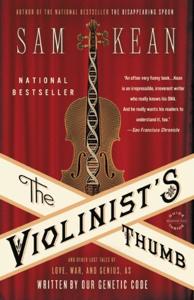
Want to learn the ideas in The Violinist’s Thumb better than ever? Read the world’s #1 book summary of The Violinist’s Thumb by Sam Kean here.
Read a brief 1-Page Summary or watch video summaries curated by our expert team. Note: this book guide is not affiliated with or endorsed by the publisher or author, and we always encourage you to purchase and read the full book.
Video Summaries of The Violinist’s Thumb
We’ve scoured the Internet for the very best videos on The Violinist’s Thumb, from high-quality videos summaries to interviews or commentary by Sam Kean.
1-Page Summary of The Violinist’s Thumb
Overview
During the early 1800s, a violinist named Niccolò Paganini was so talented that people thought he must have sold his soul to the devil in exchange for his skills. After he died, there were rumors that the church wouldn’t bury him because of these allegations.
But it turns out that Paganini’s skills were bestowed upon him by a different force. It was almost certain that he had a genetic disorder that made his fingers incredibly flexible, allowing him to play the violin with incredible skill and precision.
DNA has always been an integral part of the development of life on earth, influencing our path from single-celled organisms to become complex and intelligent beings.
In this article we will talk about how scientists discovered that genes are the basic building blocks of all life, why our origins lie with two microbes trying to kill each other and how one enterprising Soviet scientist almost crossbred humans with chimpanzees.
Big Idea #1: The groundwork for genetics was laid by two unrecognized scientists in the 1860s.
In the 1860s, Swiss biologist Friedrich Miescher was studying white blood cells at the behest of his mentor, Felix Hoppe-Seyler.
After analyzing the white blood cells from pus in hospital bandages, Miescher discovered a new kind of substance: DNA.
Unfortunately, Miescher’s discovery was not appreciated at the time. Hoppe-Seyler mocked him for his work with pus. Meanwhile, a monk named Gregor Mendel was experimenting with plants to increase crop yields.
Mendel was studying the heritability of traits in peas because they were easy to study. Peas either produced yellow or green peas and had long or short stalks, but nothing in between.
Mendel’s experiments showed that when you cross two plants with opposing traits, say yellow and green peas, the end result is never a mix of the two. This was significant because scientists had always assumed that there would be some blending between the traits.
Mendel discovered that some traits were dominant and others recessive. For example, when purebred yellow peas were crossed with purebred green ones, the offspring in the next generation were all yellow.
In the second generation of plants, Mendel found that one out of every four plants had green peas. However, in the third generation of plants, he found that three out of every four plants did have green peas again.
Finally, Mendel also found that the traits were separate from each other: one plant could have the dominant yellow pea trait and the recessive short stalk trait. This is what we call genes today.
Mendel’s work was not recognized in his time.
Big Idea #2: Fruit flies in milk bottles eventually helped explain the importance of DNA and genes.
Mendel and Miescher’s discoveries were important in the early twentieth century. Scientists discovered that chromosomes seemed to play a role in inheritance, as parents passed on their intact chromosomes to their children. More importantly, scientists found out that chromosomes are made of DNA.
More evidence was found when a Dutch botanist named Hugo de Vries discovered mutations in his primroses. He theorized that it was how new species arose, and this idea challenged Darwin’s theory of evolution, which couldn’t explain how new species formed.
A biologist named Thomas Hunt Morgan heard about de Vries’ mutations and began experimenting with fruit flies. He grew thousands of them in glass bottles for months, but he didn’t find any interesting mutations until one day a male fly had white eyes instead of red ones.
When Morgan bred white-eyed flies with red-eyed flies, the offspring were all red eyed. However, in the third generation of this experiment, white-eyed flies appeared again at a one to three ratio. This supported Mendel’s work and gave it credibility.





